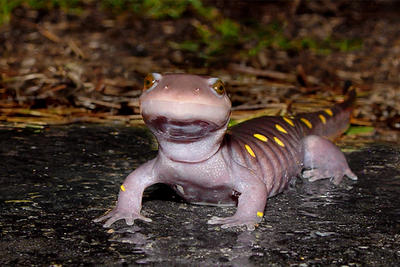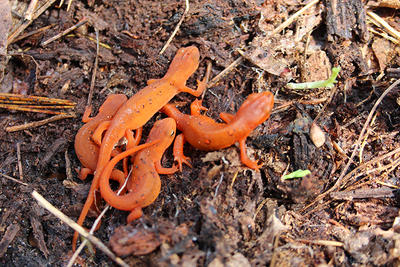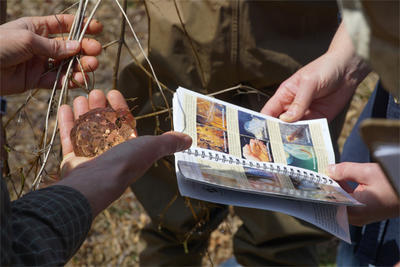A Salamander Belongs To Which Animal Group?
Salamanders are so secretive that most people never come across them!
But because of their sensitive pare and specific habitat requirements, these shy creatures can tell united states a lot about the health of our environment.
Identification
All salamanders vest to the amphibian gildCaudata, from the Latin word for "tailed." Newts and mudpuppies are also types of salamanders.
Because of their slender bodies and long tails, salamanders look somewhat similar lizards so people often misfile the two. Simply lizards are reptiles, whereas salamanders are amphibians like frogs and toads. Lizards have scales and claws; salamanders exercise not. Lizards typically have dry skin; most salamanders stay moist, and many of them use their wet skin every bit a surface through which to breathe.
Learn near salamander species in Massachusetts >
Behavior
Dissimilar frogs, salamanders are rarely vocal. Instead, they communicate using impact and chemicals. To avoid predators, they may exude bad-tasting substances. Some advertise their poisonous nature with bright colors.
For case, hikers frequently encounter manifestly defenseless orange salamanders walking on the forest floor. These are Eastern Newts in their juvenile phase (known every bit Cherry Efts), and they're extremely poisonous to eat.
Nutrient
Salamanders swallow many small-scale animals, from insects to spiders to worms. They eat several creatures that people consider pests including slugs, mosquito larvae, and flies. They will also sometimes swallow other salamanders.
Life Cycle
There's a not bad bargain of diversity in salamander life cycles. They live and breed in diverse types of water bodies or on the forest flooring, and their life cycles may encompass more than i of these habitats.
Several Massachusetts salamander species drift from their overwintering spots in wooded upland areas to breed in vernal pools during a miracle known as "Big Night". Vernal pools are temporary ponds created past leap rains and snowfall melts. They dry out up by mid-summertime, which makes them inhospitable to predators such every bit fish. Learn more almost vernal pools >
In most salamander species, breeding involves the male placing a sperm packet called a spermatophore on the ground or on droppings in a pool. The female inserts it into her cloaca to fertilize her eggs, which she may attach to sticks and leaves or under rocks. Some species baby-sit their eggs from predators until they hatch.
Many young salamanders go through an aquatic tadpole stage in which they have visible feathery gills. When they become adults, they may lose gills and proceeds eyelids and a tongue, as well as the power to walk on land.
Salamander Conservation
Amphibians all around the world are in problem. Of the 11 salamander species in the state, three are listed under the MA Endangered Species Act. They face several dangers throughout their lives, and many salamanders perish when they cross roads to attain their breeding pools. Loss of habitat is some other major threat.
Learn more
Source: https://www.massaudubon.org/learn/nature-wildlife/reptiles-amphibians/salamanders/about
Posted by: cortezsedged.blogspot.com




0 Response to "A Salamander Belongs To Which Animal Group?"
Post a Comment